If you’re interested in presenting a course online, you’ll almost certainly need a Learning Management System, or LMS — but there are so many different types of LMS out there, it can be tricky to know what you need, or even know where to start looking.
To begin with, an LMS is a software application designed to help institutions, companies large and small, and educators of all types manage, deliver and track educational content and training programs. Essentially, it’s an online platform where you keep your training materials to access remotely.
The goal of an LMS platform is to host the training materials and courses, rather than to sell them. (Some LMS platforms include ways to sell them, but those are additional features.)
There is no single best type of LMS; it all depends on how you plan to use it and what you need it to accomplish.
In this article, we’re going to discuss three of the main types of LMS and take a quick look at some other types.
⚠️ But before we go any further, let’s be sure that an LMS is what you really need — because people online sometimes use “LMS” as an umbrella term for any online course platform. Sometimes, they might think they need a full LMS, when really they need an LMS plugin or an online course platform.
Is an LMS the Right Tool for You?
The type of LMS you use to manage your online courses will all depend on your needs and how you plan to use the tools.
Choosing the right type of LMS for your situation depends on:
- Your budget
- The size and bandwidth of your team
- The time you have to build and manage the LMS
- The time you plan to use the LMS
It can get confusing because people often use LMS as an umbrella term, but you’ll also want to consider whether you might want to use a “pure” LMS, an LMS plugin for your existing website, a standalone platform, or a course marketplace.
We’ve put together this decision tree to help you find the right solution for you:


💡 If an LMS plugin, course marketplace, or course platform would be a better fit for your needs, check out our other in-depth comparisons.


The 3 Main Types of LMS
OK, assuming you’ve confirmed that you need a “pure” LMS, there are three main types of LMS systems: Cloud based, open source, and installed. Let’s look at the differences between the three.
1. Cloud-Based LMS
What Is a Cloud-Based LMS?
A cloud-based LMS, also sometimes called “SaaS” or “web-based” LMS, is hosted on the cloud and licensed to you by a provider. Cloud-based LMS providers handle all the hardware, server infrastructure, updates, and maintenance, as everything you and your students use is accessed remotely, via the cloud.
Cloud-based LMS types mean you don’t need to download anything or install any hardware — and neither do your students. You get access to all the features and integrations automatically.
If you need help, you’ll be able to access tech support via your LMS provider.
Some key features of SaaS LMS include:
- Intuitive user interfaces
- Diverse content support
- Robust course management
- Assessment tools
- Tracking
- Collaboration tools
- Gamification
SaaS LMS make mobile learning easy, and often integrate with your existing HR software and other systems.
Pros & Cons
- Flexibility
- Accessibility: allows users to log into the LMS from any place with an internet connection
- Scalability: it provides a scalable infrastructure, allowing LMS to accommodate varying numbers of users and courses easily
- Rapid deployment: these solutions typically boast faster deployment times in comparison to traditional software installations
- Cost-efficiency: reduces the necessity for organizations to make significant investments in on-site infrastructure and continual maintenance.
- Limitations in customization: restriction on customizing or personalizing the platform for specific employee training requirements
- Price: requires a monthly fee.
Pros
- Flexibility
- Accessibility: allows users to log into the LMS from any place with an internet connection
- Scalability: it provides a scalable infrastructure, allowing LMS to accommodate varying numbers of users and courses easily
- Rapid deployment: these solutions typically boast faster deployment times in comparison to traditional software installations
- Cost-efficiency: reduces the necessity for organizations to make significant investments in on-site infrastructure and continual maintenance.
Cons
- Limitations in customization: restriction on customizing or personalizing the platform for specific employee training requirements
- Price: requires a monthly fee.
Who Is a SaaS LMS Ideal For?
A SaaS LMS might be ideal for you if:
- You have a smaller IT staff and require more technical support
- You have moderate data protection needs
- You require faster deployment
- You have minimal-to-moderate customization needs
- You prefer predictable monthly or annual costs.
Examples of SaaS LMS
Docebo
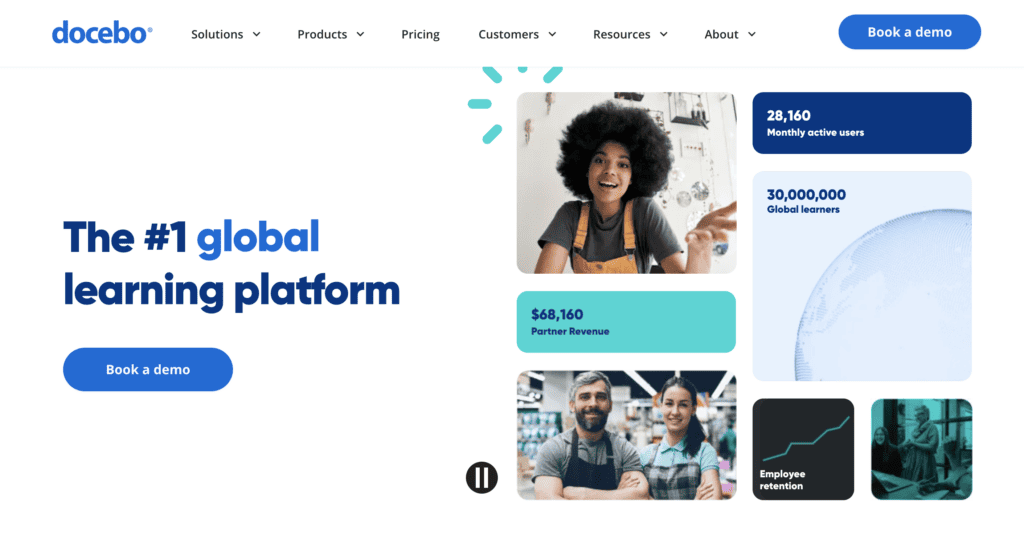

Docebo is mainly designed for education for corporations and large businesses, including employee onboarding, compliance training, sales enablement, customer education, and talent development. It has built in generative AI to help personalize learning experiences and automatically identify skills gaps as well as automate administrative tasks and workflows. They offer robust analytics to help prove the ROI of the trainings against business outcomes.
360 Learning
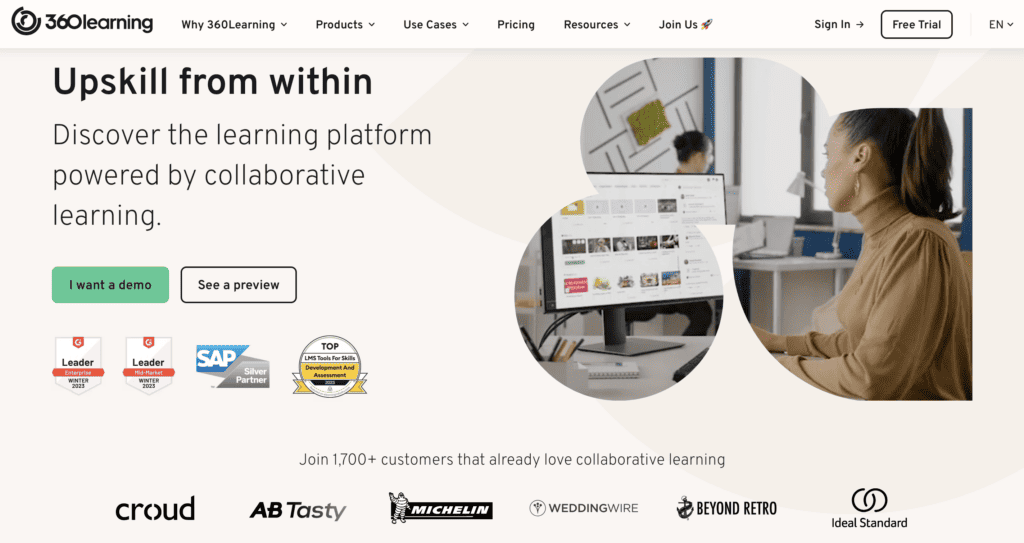

360Learning helps companies upskill from within with a focus on collaborative learning. The goal with their platform is to allow any subject matter expert from within an organization to teach. They can help you automate and manage mandatory compliance training, eliminate busywork in employee onboarding, train sales and other teams with 1:1 video coaching at scale, and equip frontline staff with relevant training available on any device.
Litmos


Litmos can be deployed within minutes with off-the-shelf content available for compliance training, leadership, management, communications, and a variety of other skills available. From there, your team can create their own content with built-in content authoring tools designed for everyone from the novice trainer to the professional in mind. And end users can access the information from anywhere, 24/7, with a variety of disability features and 35+ languages to help eliminate any barriers to learning.
LearnUpon


LearnUpon prioritizes putting the learner first by providing an easy, engaging, enjoyable learning experience. They streamline how you create, manage, track, and deliver learning for employees, customers, partners, members, or any other audience within their single solution. And, they have a dedicated expert Customer Experience team ready to work with you to create a personalized strategy for success.
TalentLMS
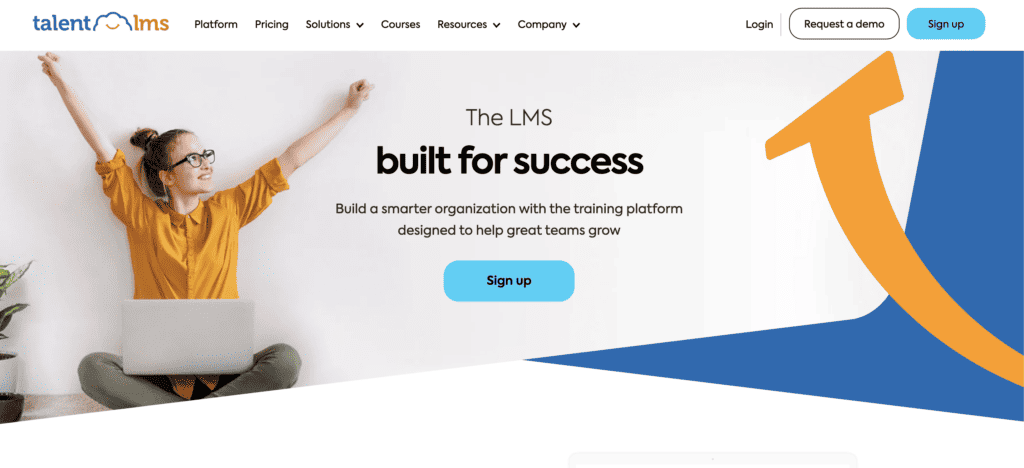

TalentLMS features an intuitive interface that can be accessed from any device and a quick setup process so that you can be up and running in a matter of hours, not days or weeks. It offers customization for your branding, so that users immediately feel like they’re in the right place, and you can select the default language by location, so they can get started right away. They also offer a library of ready-made courses to supplement your own training materials and get you running ASAP.
Coassemble


CoAssemble makes creating your course materials literally as easy as clicking a button. Select a theme and customize it to your branding, then import any file type to create interactive learning screens. Then use their AI-powered quiz generator to assess how well your learners absorbed the material and then track user engagement, completion, and sentiment as they go through the course. Plus, you can start using their course builder for free.
2. Open-source LMS
What Is an Open-Source LMS?
An open-source LMS type is a collaborative system that has been developed by multiple users who share code, enabling the addition of new features and the correction of bugs and defects as needed.
Probably the most famous example of open-source software is WordPress, and open-source LMS work the same way. An open-source LMS can be delivered as a cloud-based SaaS product or an installed LMS.
Open-source LMS platforms are free to use and can be customized extensively to meet your specific requirements; but achieving this level of customization requires a certain level of design and development knowledge and resources, as you’ll need to adapt the existing code to suit your company’s needs.
Open-source LMS serve as a middle ground for organizations that want something entirely custom — but don’t want to have to start entirely from scratch.
Pros & Cons
- Free to use
- Unlimited customization: thanks to open-source, you can customize everything to suit your needs
- Security: you control everything that happens at every step
- Scalability: no limitation in terms of growth.
- Security: users may insert insecure code or make poorly written or untested changes to the codebase
- Users need to invest considerable effort and customization
- You are in charge of upgrading or fixing any bugs
- Design and development resources are necessary
- Making updates may not be as straightforward as the initial setup process.
Pros
- Free to use
- Unlimited customization: thanks to open-source, you can customize everything to suit your needs
- Security: you control everything that happens at every step
- Scalability: no limitation in terms of growth.
Cons
- Security: users may insert insecure code or make poorly written or untested changes to the codebase
- Users need to invest considerable effort and customization
- You are in charge of upgrading or fixing any bugs
- Design and development resources are necessary
- Making updates may not be as straightforward as the initial setup process.
Who is an Open-Source LMS ideal for?
Open-source LMS are a great fit for you if:
- You’re looking for infinite customization and flexibility
- You have a budget to respect
- You have enough technical knowledge and resources.
Examples of Open-Source LMS
Moodle


Moodle is a fully customizable learning management system aimed at K-12 and higher learning institutions. It offers different activity and task formats to accommodate many types of learning preferences, offers email and mobile app alerts to help keep learners on track, and is accessible from any browser or device. Moodle offers a variety of integrations with other services and strong privacy and security features necessary for working with students of all ages.
ATutor
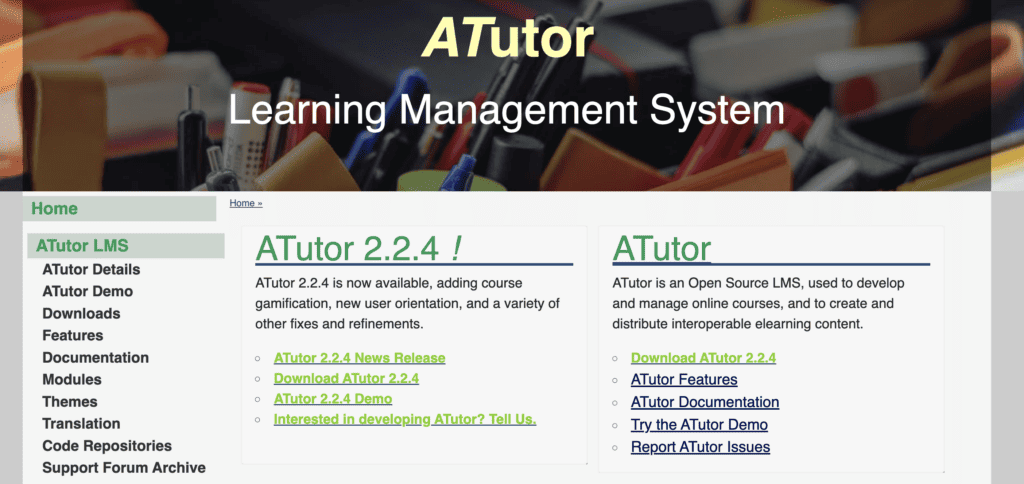

ATutor was developed with accessibility as a priority, including features that allow the student to configure their learning environment to their needs. ATutor also includes a social networking feature for both students and instructors, as well as private and group messaging, group blogs, work groups for collaboration, discussion forums, and chat rooms, based on your groups’ needs. It also provides a wide suite of tools for educators, administrators, and developers.
Chamilo


Chamilo is the result of a non-profit originally started in Belgium and now headquartered in Spain to provide free e-learning software and improve access to education. It’s a light, easy-to-learn and easy-to-deploy LMS with many customization options. The community is small, but growing and features are added regularly.
Open edX
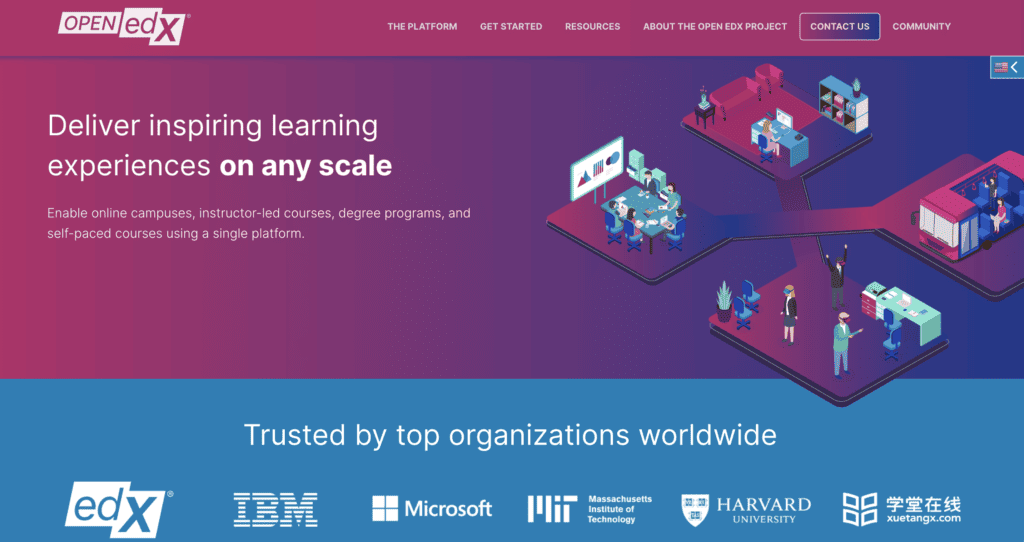

Built for scale, OpenEdX can support small learning groups or groups with thousands of learners. The brand was co-founded by Harvard and MIT and was originally envisioned to help these institutions deliver their MOOCs (massive open online courses). It has since evolved into one of the leading online learning platforms for institutions of all types.
Ilias


ILIAS is one of the oldest learning management systems around, and has been serving higher education institutions, schools, businesses, and public institutions for more than 20 years. They offer extensive help documentation, forums, and a network of professional service partners around the globe so that even schools and organizations with a small budget can get set up and share their knowledge.
Forma LMS
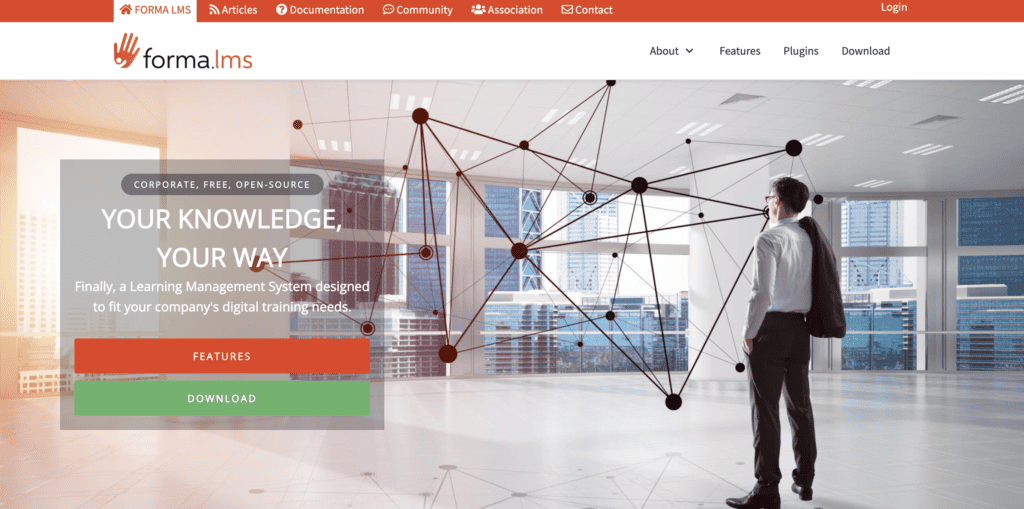

Forma is an open-source LMS built specifically for corporate trainings. You can use it to develop internal trainings at enterprise scale, create trainings for partners outside the company, and even use it as a content hub to sell individual trainings to customers. You can configure the standard features exactly to your liking, connect other systems with APIs and plugins, or build your own custom features as needed.
3. Installed LMS (On-premise)
What Is an On-Premise LMS?
An on-premise LMS is locally hosted, which means it must be installed on a physical server at your organization’s location.
With an on-premise LMS, your organization is responsible for the server including setup, maintenance, and upgrades of the learning platform. The LMS software itself can be purchased and installed on your server for independent implementation and operation.
But with the advent of cloud-based SaaS learning management systems, on-premise systems are less popular these days.
Pros & Cons
- Security: you’re in charge of your server and its security
- Customization power: tailor every aspect of the software to your needs
- Local database storage: store your database locally, minimizing security risks.
- Server space: as your academy expands, it may occupy significant server space and incur higher maintenance costs over time
- Cost: it can be relatively expensive due to the associated responsibilities
- Downtime challenges: addressing unforeseen downtime issues is your responsibility.
Pros
- Security: you’re in charge of your server and its security
- Customization power: tailor every aspect of the software to your needs
- Local database storage: store your database locally, minimizing security risks.
Cons
- Server space: as your academy expands, it may occupy significant server space and incur higher maintenance costs over time
- Cost: it can be relatively expensive due to the associated responsibilities
- Downtime challenges: addressing unforeseen downtime issues is your responsibility.
Who is On-Premise LMS ideal for?
An on-premise LMS might be best for you if:
- You have a substantial IT team capable of in-house system implementation and management
- You need extensive customization
- You prioritize LMS performance
- You prefer a larger upfront fee over perpetual subscription costs
- Security is your number 1 priority.
Example of Installed LMS
Moodle BizLMS
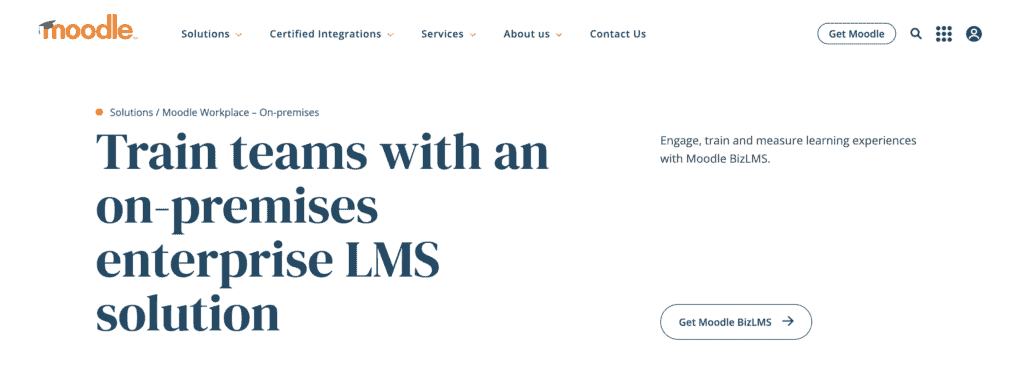

Moodle is an open-source LMS that can be installed on-premise. This self-hosted solution gives you complete control over workflows and helps you easily manage your learning management system while protecting privacy and security of your data.
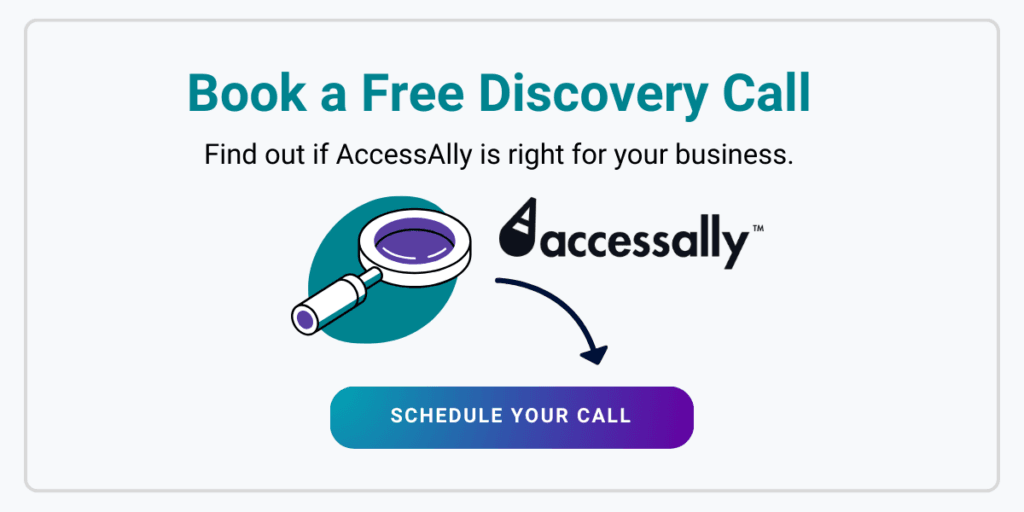

Some Other Types of LMS
As we mentioned above, there are some other types of LMS you should be aware of:
Proprietary LMS
Proprietary LMS are systems developed by a specific company or institution. Some sell access to their proprietary system, which typically entails a licensing fee. They provide some small amount of customization, but often have limitations in modifying the core functionalities.
Custom-Built LMS
A custom-built LMS involves an in-house team or external consultants starting from scratch and building an LMS to an organizations exact specifications. They’re typically on-premise, which means they inherit both the advantages and challenges of on-premise systems.
Compared to other LMS types, the functionality of these systems is often simpler, usually because they’re newer and have fewer dedicated resources to building and upgrading them.
The main advantage of a custom-built system is that it meets the exact requirements of the organization building it. But, the big drawback is that maintenance is usually handled by a small team in house, which can pose challenges in the case of employee turnover or outages.
Enterprise LMS
An enterprise LMS or “commercial LMS” is specifically designed for organizations with 500 or more employees or learners requiring training. They are designed to facilitate the management and delivery of corporate training for tasks like onboarding, upskilling, and reskilling.
They can also serve as a valuable tool for educating external individuals including customers and partners.
Enterprise LMS play a crucial role in maintaining certifications and ensuring compliance with federal and state regulations. Want some more comparisons?
✅ You can also check out the 6 Best LMS and how they stack up to one another here!




